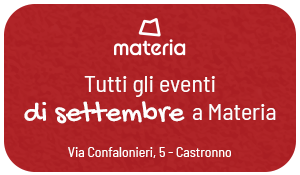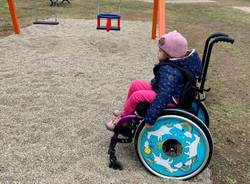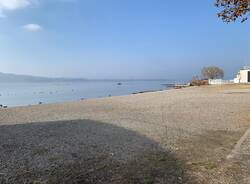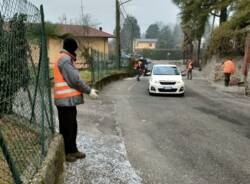The garden in March: big and little jobs, for the big and little ones
How can we take full advantage of our garden and also involve our children? Here is some advice for the month of March

Spring is beginning to add colour to our gardens, the days are getting longer and, especially at the moment, it is increasingly difficult to fill them for our children, who are at home from school or pre-school.
Which jobs in the garden need to be done at this time of year? Here are the suggestions of the staff at Agricola Home&Garden. And how do we get the little ones involved? We put these questions to Silvia, from the association “La Bottega delle Scoperte”, in Besozzo, near Varese.
FOR THE LITTLE ONES
The mud kitchen
Let’s use the old pots and damaged utensils that fill our drawers and cupboards, to build a real mud kitchen. We’ve all done it and we know how much fun it is. This time, the children are allowed to get their hands dirty, as they make curious meatballs or cakes using soil and water, which can be dried in the sun. Seeing the joy on their faces is payment enough for having to load the washing machine once more.
The sound garden
All you need is two funnels and a tube, which you pass among the branches of a tree or the leaves of a hedge to create a fun telephone, which amplifies the sound and the enjoyment. What about using recycled materials, which you can hang on a gate or on the balcony, to create a xylophone or some wind-chimes?
The green planet
Even if you have a small garden, you can involve your children in taking care of it, and together with them, give a fun name to every area. The ivy-filled corner in the shade is the mysterious Ivy Swamp. And those branches and dry leaves gathered in another corner are undoubtedly the Brontosaurus’s Nest. The bed of aromatic herbs is none other than the Planet of curious noses. Unleash your imagination. You can make signs and cover them with transparent plastic.
My first herbarium
Imagine a book of magic formulas and spells, like those of Harry Potter, made of rare and mysterious ingredients which you can find in your garden. Encourage the little explorers to pick as many examples of leaves and flowers in the garden as they can, and get them to store them in their first herbarium. Get your children to note down some curious details or information about each plant, as well as its Latin name, which you can find with a simple Internet search.
FOR THE BIG ONES
While the children are busy looking for mysterious plants or playing “melodies” on recycled materials, the adults can take care of the garden.
Plants and flowers: what to plant
We know that, in March, the weather is unpredictable, but if we are quite sure that the winter night frosts are behind us, we can already think about planting the summer and autumn flowering bulbs.
We can also take the opportunity to plant shrubs, fruit trees and roses.
Let’s take care of the perennial herbaceous plants, which need to be cleaned and divided. Although the cheapest way to have more perennials is sowing, it is also true that it often takes years to get plants to flower in this way. So, to get blooming flowerbeds of perennials, you should divide the tufts, bulbs or tubers according to the type of plant, and replant them immediately.
Lawn: mow, aerate and save
The second half of March is a good time to mow the lawn for the first time and then scarify it, to aerate it. What does this entail? This operation, which is recommended in autumn and in spring, entails removing the moss that grows at the base of the grass stalks as a result of water stagnation and a lack of transpiration of the soil. To do this best, use a suitable tool and soften the soil, wetting it just before you start.
When the lawn has been aerated, you should proceed with reseeding the parts that have been most affected by the winter frosts. Choose lawn seeds on the basis of the exposure to light or to trampling, and use a roller to compact the soil, make the seeds stick and, when they start to sprout, help the small roots to take hold.
Remember to fertilise before sowing and water every day until the seeds sprout (usually about 20 days).
Fertilisation
This is the ideal time to fertilise. The upcoming spring rains will help the soil to absorb all of the necessary substances deep down and “softly”, when diluted. But how do you choose the most suitable fertiliser?
There are various types of fertilisation:
– Fertilisation with nitrogen: quantitatively, this is the most important element for plants; it affects the total development, gives leaves a beautiful intense green colour, prepares the plant for flowering and strengthens it.
– Fertilisation with phosphorus: this element helps the plant to flower, and when the fruit is ripening.
– Fertilisation with potassium: this intensifies the colour of the flowers and the flavour of the fruit.
– Fertilisation with calcium: this is administered only to soil that lacks it, or when growing plants with specific needs.
If you have any doubts or need advice, you can count on the Agricola staff.
For advice > Agricola Shop
To order plants, tools, soil and fertilisers, which will be delivered directly to your home > supporto@agricolashop.it
TAG ARTICOLO
La community di VareseNews
Loro ne fanno già parte
Ultimi commenti
mike su La neve in montagna continua a sciogliersi. Contro la siccità si aspetta la pioggia
Felice su La festa "techno" nei boschi di Lonate Ceppino causa proteste
Rolo su Pullman in sosta con i motori accesi, la segnalazione e la risposta di Autolinee Varesine
lenny54 su "C'è del dolo nelle modifiche al Superbonus"
Felice su Architetti, geometri, ingegneri e costruttori all'unisono: "Da Super Bonus a Super Malus"
Felice su Dentro la loggia del Battistero di San Giovanni a Varese restituita alla città



















Accedi o registrati per commentare questo articolo.
L'email è richiesta ma non verrà mostrata ai visitatori. Il contenuto di questo commento esprime il pensiero dell'autore e non rappresenta la linea editoriale di VareseNews.it, che rimane autonoma e indipendente. I messaggi inclusi nei commenti non sono testi giornalistici, ma post inviati dai singoli lettori che possono essere automaticamente pubblicati senza filtro preventivo. I commenti che includano uno o più link a siti esterni verranno rimossi in automatico dal sistema.